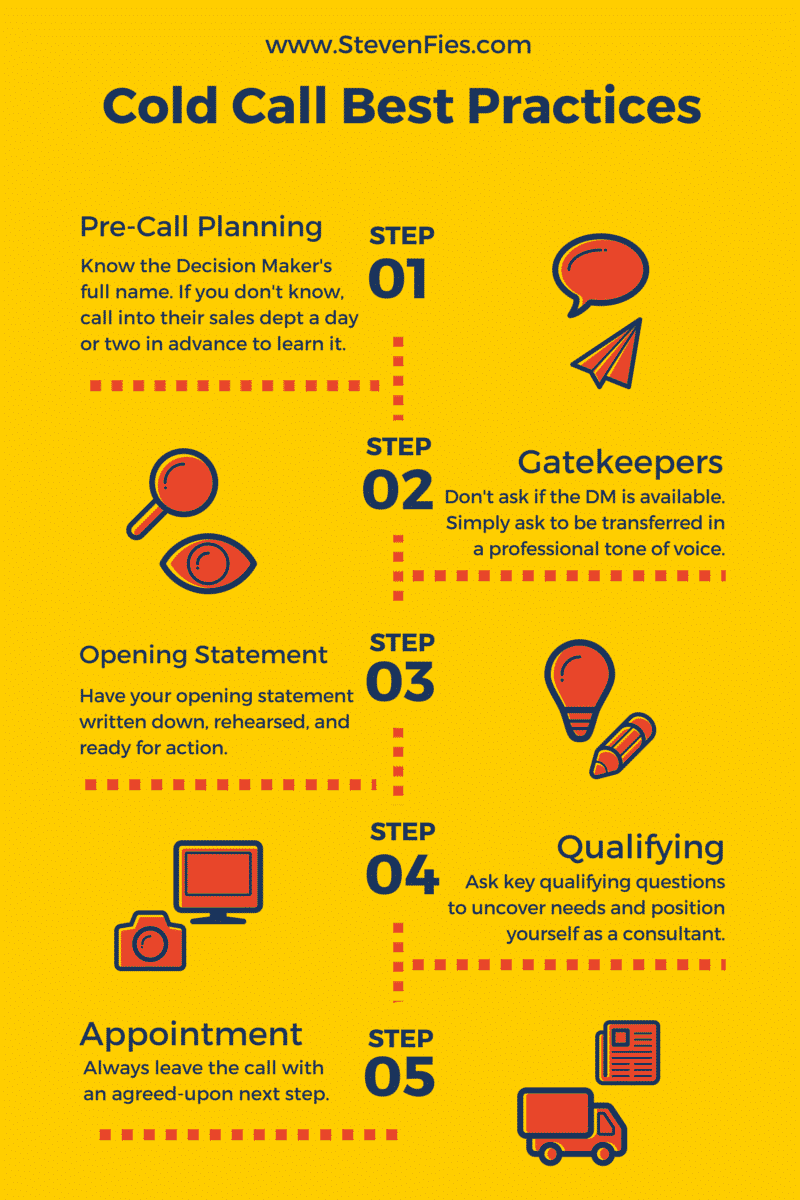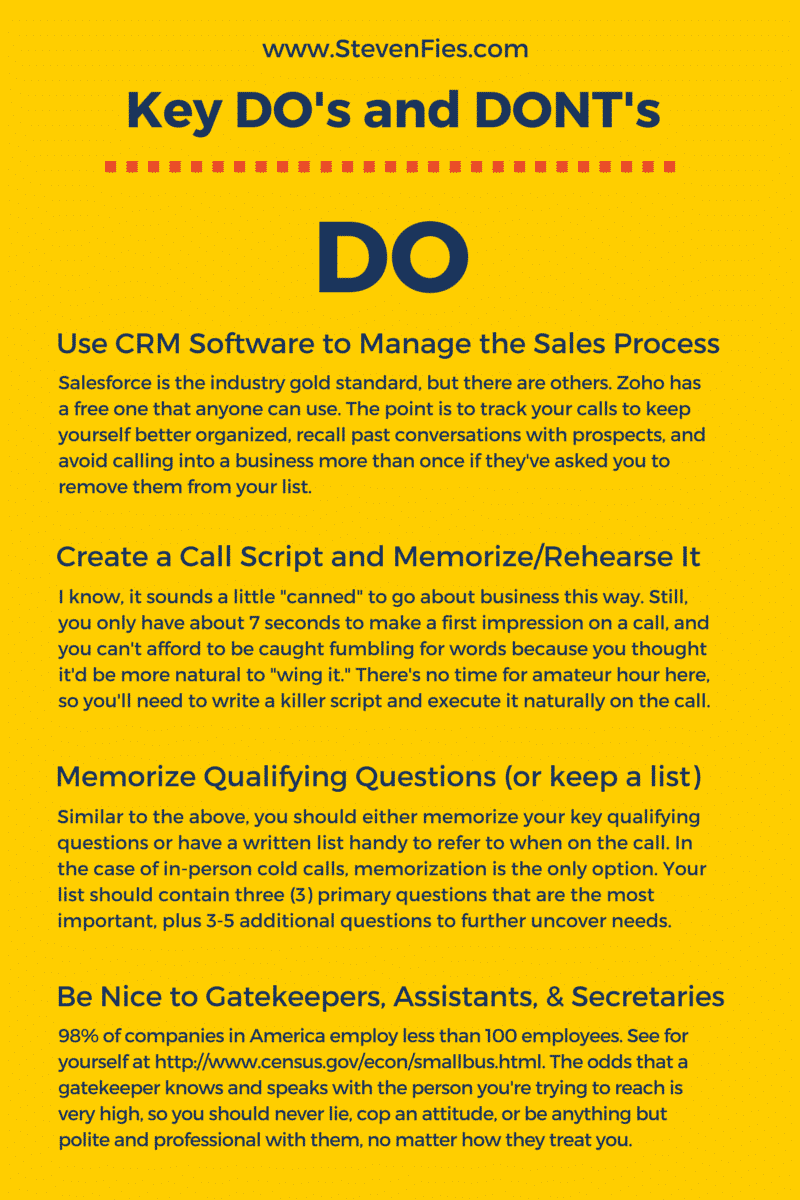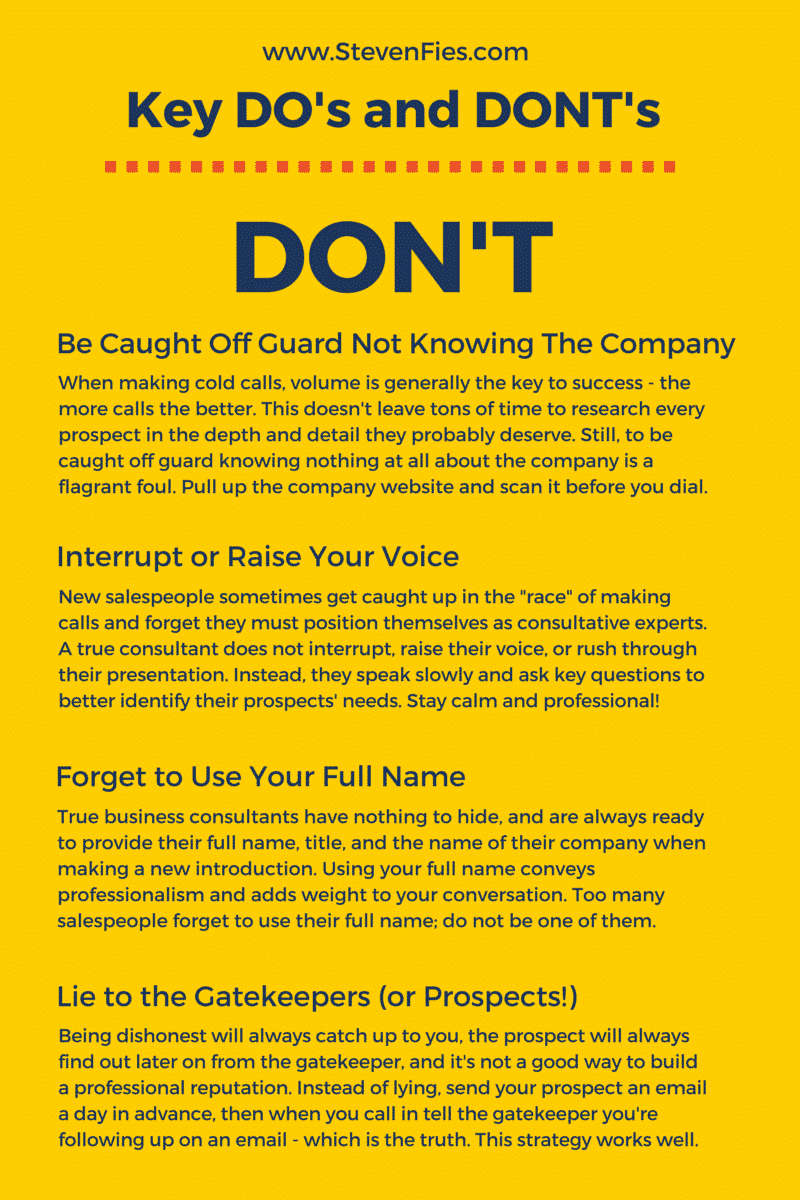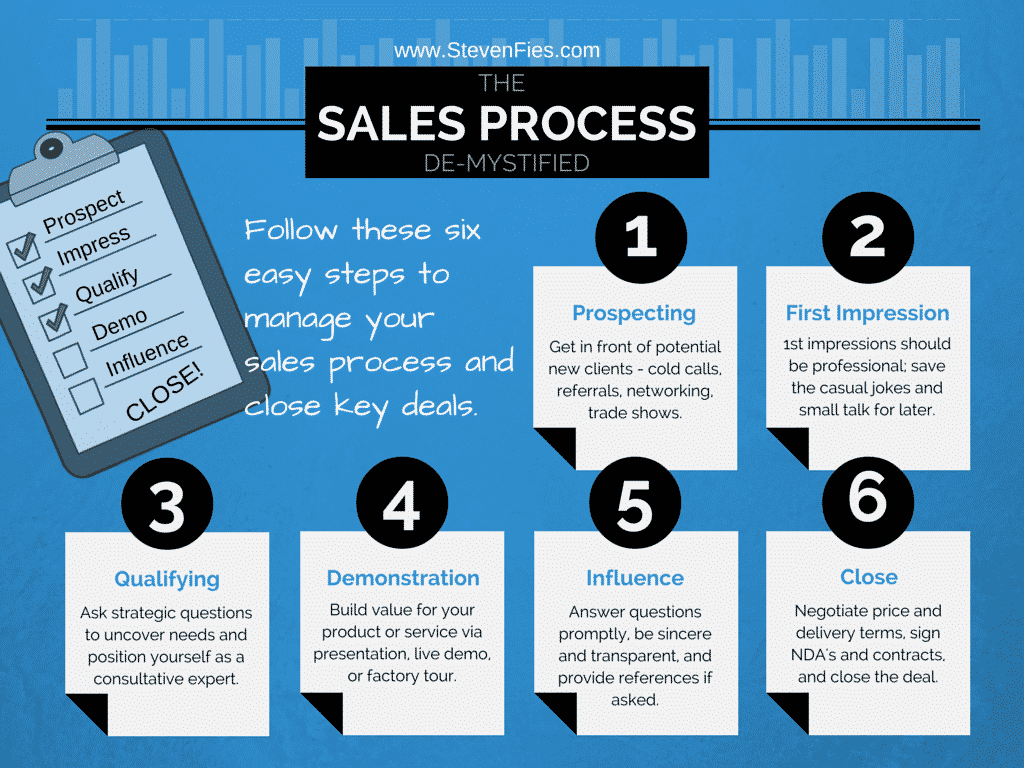“Cold calling is dead.” …or is it?
In this article, I’ll do my best to share with you a few things I’ve learned after several years of working in sales. Let’s start with the infographic I made illustrating some best practices for making a cold call:
Grab the PDF with all three of the above infographics here.
How I picked up a $100,000 account with one simple, in-person visit off the clock.
Now what if I told you as a professional salesperson, I picked up an account that produces $100,000.00 in new business for my company every year by making just one cold call (off the clock, too) – and in-person, at that? What if you could pick up that type of business with one measly business card like I did?
Whether you’re in sales full-time or starting your own business as an entrepreneur (which also means you’re in sales now, by the way), the cold call is an incredibly effective way to drum up new business.
Just because the “conversion rate” is low doesn’t mean it doesn’t work. Don’t listen to the people who say cold calling is dead – it’s just not popular, and many people simply aren’t prepared to deal with the frequent rejection that comes along with it.
For those who can handle the hustle, the payoff can be huge – salespeople are often the highest-paid in their organizations alongside management and executives. (At one company I worked for, our top salesperson was paid more than the President.)
I know tons of people in sales across multiple industries (branded merchandise, tech/software, professional services, real estate, airplane sales…) who make multiple six figures in sales.
The big account (and the back-story behind it).
Prior to moving to Austin, TX with my family in August 2014, I worked full-time as a project manager and salesperson for Promoventures, Inc. in San Diego, CA. Since then, I’ve continued to work for the company as a private consultant and outside salesperson, but my best stories from Promoventures are certainly those from before my family’s big move.
One of my memorable successes back in San Diego, CA, where Promoventures’ 17,000 square foot warehouse is located, was to land a new account with one of the top craft breweries in San Diego. This is a top-notch, professional microbrewery that is now rivaling the likes of Stone Brewing Company, Ballast Point, and several others in the area.
Over the course of time, this particular client has come to order a sizable portion of their branded merchandise and apparel from my company. We’re talking screen printed tees, tanks, and hoodies; trucker hats and embroidered caps; imprinted glassware; and a long list of related promotional products for resale. It’s a great relationship and I have such amazing things to say about the people working at the brewery. It has always been an absolute pleasure (not to mention lots of fun!) working with them.
How, though, did the relationship begin?
One night after work, I dragged my boss and a co-worker down to this particular brewery to grab a quick beer. Knowing this brewery was not a current client, I figured I’d take a stab at picking up their t-shirt business by handing one of my business cards to the bartender.
I introduced myself, gave her my card, and explained we were located nearby and could probably streamline their merchandising efforts. She smiled and said thank you, and indicated that she would pass it along to the correct point of contact for me – and as is usually the case, she added in, “…they will be in touch with you if there’s any interest.”
After few weeks passed by, I had nearly forgotten about all of this when the purchasing manager from the brewery filled out a contact form on our website. As it would turn out, she had received the business card I submitted previously and figured she’d give us a shot.
In that particular moment, she was in need of ordering a branded event canopy and sought a price quote. Of course, I jumped on her request right away and took things a step farther by inviting her to visit our warehouse for the grand tour.
After all, seeing production in action (all of our screen printing machines, embroidery, etc.) is pretty impressive and I knew the tour would be a good chance for her to see first hand how we operate. In-person client tours always provided a great opportunity for me to educate new clients in our production processes, answer their questions, and begin building a deeper relationship.
When my client arrived for her scheduled tour, I guided her through our facility and pointed out the quality features of our production processes. This also doubled as an opportunity for her to see some of the current jobs we were running for Fortune 500 companies, adding credibility and allowing her to contemplate creative new ideas after seeing what other, larger companies were doing.
As a matter of fact, by the end of our tour she actually asked me if her purchasing needs might be too small considering the sheer volume of work these other accounts were bringing us! With pallets and pallets of boxes stacked high in our warehouse for other clients, I could understand her concern that we might not service her business at the same level since she was a bit “smaller.”
Of course, I gave her the proper reassurances and had every confidence in doing so, as Promoventures has always placed great focus on excellent customer service regardless of order size.
After the tour, my client proceeded to order the canopy she originally inquired about and was satisfied with its quality upon delivery. Shortly thereafter, we started to discuss production possibilities for things like t-shirts and other decorated apparel items that might be resold at the brewery.
One thing led to another, and just a few weeks later I’d entered two new orders for my client totaling over $20,000. This was a big jump from the $700 canopy from her initial order, and business volume has grown steadily since then.
4 Key Lessons Learned
1. Cold Calling is Alive and Healthy
I will be the first person to admit there are (often) more effective ways to generate customer leads than cold calls.
Referral selling, networking, and attending trade shows are all “higher conversion” ways to generate new business – sure. This still doesn’t change the fact that cold calls can be effective, which is why tons of businesses around the world continue to employ this method as a primary sales and growth strategy.
Since I’ve moved to Austin, I have only seen more evidence of this – local tech start-ups like MainStreetHub and Signpost rely on cold calls as a primary means of reaching new customers (Signpost is financially backed by Google, by the way).
The fact is, not every business is content to grow at a pace dictated by the arbitrary number of referrals they can generate from existing customers, or the number of trade shows they can attend in a given fiscal year or quarter. Not to mention, what about new businesses with few (if any) referral sources when starting out, and limited budgets to attend big trade shows?
Where more aggressive growth is sought, outbound prospecting for possible new leads is king. The downside to aggressively cold calling, of course, is that the individual sales reps making the calls may struggle to stay motivated when encountering so many prospects who don’t need their company’s products or services, or who are satisfied with their existing vendor(s).
But as mentioned at the beginning of this article, for those that can handle it, they are bound to stumble across some great deals from time to time if they keep at it – and as salespeople, the commissions can instantly boost their earnings to levels previously only attainable through decades of climbing the “corporate ladder,” which frankly sounds much worse to me than dealing with a few “No” answers throughout the day from new business prospects.
As a case in point, I was able to nearly double my base salary in a relatively short period of time (less than 1.5 years) by making outbound calls for just an hour or two per week at my job. Sales is not for everyone, but the dedicated prospector stands to see significantly higher personal earnings than most of America if he/she sticks with it over time.
2. Success = Diligence + Luck
I’ve been reading this amazing book called Thinking Fast and Slow by Daniel Kahneman, a winner of the nobel prize in Economics and a researcher who has revolutionized the fields of Psychology, Statistics, and several others throughout his career.
One of the more sobering principles Kahneman discusses in Thinking Fast and Slow is the significant role of luck in personal and professional success. He discusses how the effect of luck is ever-present in stock trading, a CEO’s business strategy, our personal decisions, and more.
Through highly validated statistical analysis, he strips away the pride stock brokers, chief executives, and the rest of us have in our career successes – primarily by showing how:
- Correlation does not equal causation (a common logical fallacy).
- Regression to the mean controls the outcome of events over time.
- We as humans often make connections between things in our minds where connections simply do not exist.
Anyone who has spent any length of time cold calling intuitively understands the role of luck in landing deals, because so many factors are out of your control. There are gatekeepers to get past, decision makers who always seem to be in meetings or out of the office, and other vendors who have already established long-standing relationships with target customers.
To reach a decision maker and have a really great conversation that leads to a proposal and a closed deal isn’t a “high-probability” event when you consider the nature of cold calls, after all. But sometimes the stars do align and the deals do get closed, and in many cases they can be quite large at that.
The great thing about luck, though, is that you can manufacture more of it for yourself by playing whatever game you’re playing more often. In the case of cold calling, this means making more calls of course – whether in person, over the phone, through email, social media, or otherwise. You won’t always be in the right place at the right time, but if you keep putting yourself out there to the world, the day will come when you are in the right place at the right time.
Marketing relies on the same principle. Advertisements are largely overlooked, whether online, on TV, or in print – and conversion rates are similarly low. Only a small percentage of people viewing the ads will be the right people in the right place at the right time. But such is the nature of business development, and in the sales and marketing world we accept the fact that our message must be broadcast to lots and lots of people (or businesses) in order to acquire the growth we seek.
3. Sales Cycles are Long
Well, perhaps this should be re-worded to “most sales cycles are long.” I’ve had one-call closes in the past and so have others, but the truth of the matter is that it takes time to build trust, uncover needs and wants, submit proposals, work through the details, negotiate, and wait for a potential client to evaluate their options before (hopefully) finding a decision maker to sign off.
In the case of my brewery client, several weeks passed after I dropped off my business card initially, and then there were some additional days in between the time my prospective client submitted her contact form (on my company’s website) and the time she stopped by to take the grand tour of our facility.
Several more days passed after that before I received the approval for her initial Canopy order, and then many more weeks passed after that before putting in her “bigger” order for more than $20,000 worth of merchandise. After that, and to this day, it is not uncommon for there to be many weeks – sometimes months – in between orders, with certain price quotes being shot down while others get approved.
The bottom line here is that sales is not an exercise in immediate gratification. Rather it is an exercise in patience and resilience, a game in which perfection will never be achieved. New entrepreneurs who have little experience with business development should learn to embrace this as quickly as possible, rather than get mired in self-pity for their losses or lost in endless (and needless) retroactive analysis of situations where a customer did not buy.
The normally clever entrepreneur may think he or she will be able to “solve the mystery” of the lost buyer if they just think about it hard enough, and that with the right approach or tactics perhaps next time will be different. But – while it’s always great to reflect and improve – you will never “outsmart” a buyer who simply isn’t going to buy and no amount of strategizing is going to change that.
Therefore, beyond the basic reflect-and-learn process we should all engage in periodically, it is best to simply realize not everyone will buy and get over it so you can continue moving the ball forward. Namely, prospecting for new business (even more specifically… buyers who are closer to making a purchase decision, and who have the financial means and authority to do so).
It may take a while to build a healthy sales pipeline, but with dedication and persistence it can and will be done, so long as the market is there to support it.
4. Sales is a Process Requiring Solid Execution in Each Phase
Yes, sales is a process. For anyone who has been in sales (or marketing) before, this is relatively obvious. However, it’s not always obvious to someone looking into the sales and marketing world from the outside. What does this mean, though?
In the case of my new brewery client, think about the various steps or phases that transpired between the initial point of contact and the first sale. There was the initial moment where I handed my business card to the bartender, the request my prospective client submitted for information, the tour of our facility, some additional emails to answer questions after the fact, the price quote I submitted for approval, and ultimately the sale. To break this down into even more detail, consider the following steps in a traditional sales process:
- Prospecting
- First Impression
- Qualifying
- Demonstration
- Influence
- Close
Prospecting can be thought of as all the activities you do to get yourself in front of new, prospective customers. Whether this is cold calling, using SEO to drive inbound web leads, or asking current clients for referrals — this is the stage where you dump as many people as possible into your “sales funnel” to see who might make it to the bottom.
First Impressions are important for obvious reasons, and should be managed in a professional manner. Even in sales situations and industries where things might be kept a little lighter, it’s generally smart to impress with a professional first impression, and save the cracking of jokes and personal relationship-building stuff for later.
Qualifying is a process where a set of strategic questions is asked to uncover a prospect’s needs and wants. By asking the right questions and showing sincere interest in the welfare of your prospective client and his/her business, it is possible to position yourself more as a consultant and less of a salesperson.
Demonstration is the explaining/showing of one’s product or service to that prospect. In my case, it was the factory tour — in other cases, it might be an online GoToMeeting or an in-person presentation done at the client’s location in conjunction with PowerPoint slides.
Influence encompasses any conversation and Q&A that might occur after the initial demonstration. It will often come in the form of many emails and phone calls where your prospective client asks clarifying questions about your product, or asks questions about your business including the occasional request for a list of references. The key to this stage is to follow up promptly and to be honest and transparent about product/service capabilities.
Finally, the Close is the last bit of negotiation and sorting out of details that must occur in order for the sale to be completed. This may include the signing of NDAs (Non-Disclosure Agreements), vendor contracts, the transfer of certain electronic files needed for production, price and/or volume negotiation, and terms of delivery.
Conclusion
Hopefully this information provides you with a solid understanding of the sales process and how cold calls are supposed to work. Whether you’re a newbie or veteran salesperson, or someone considering a career in sales, it’s my hope that you are now enlightened in some meaningful sense of the word.
By the way, if you’re interested in learning how you stack up against top sales performers, feel free to contact my company for a certified sales skills index examination. This assessment will test you in depth on every area of the sales process, show you graphically how you compare to top performers (based on compiled research from more than 30,000 salespeople across various industries) and point out the areas your strengths to capitalize on and weaknesses to improve.




